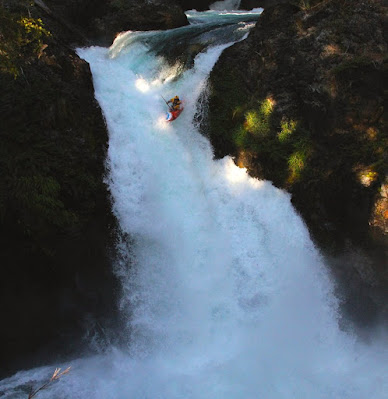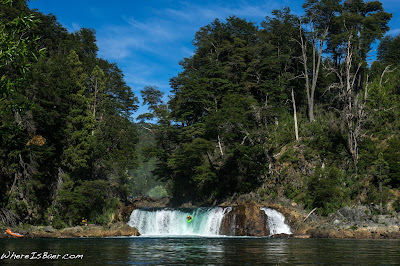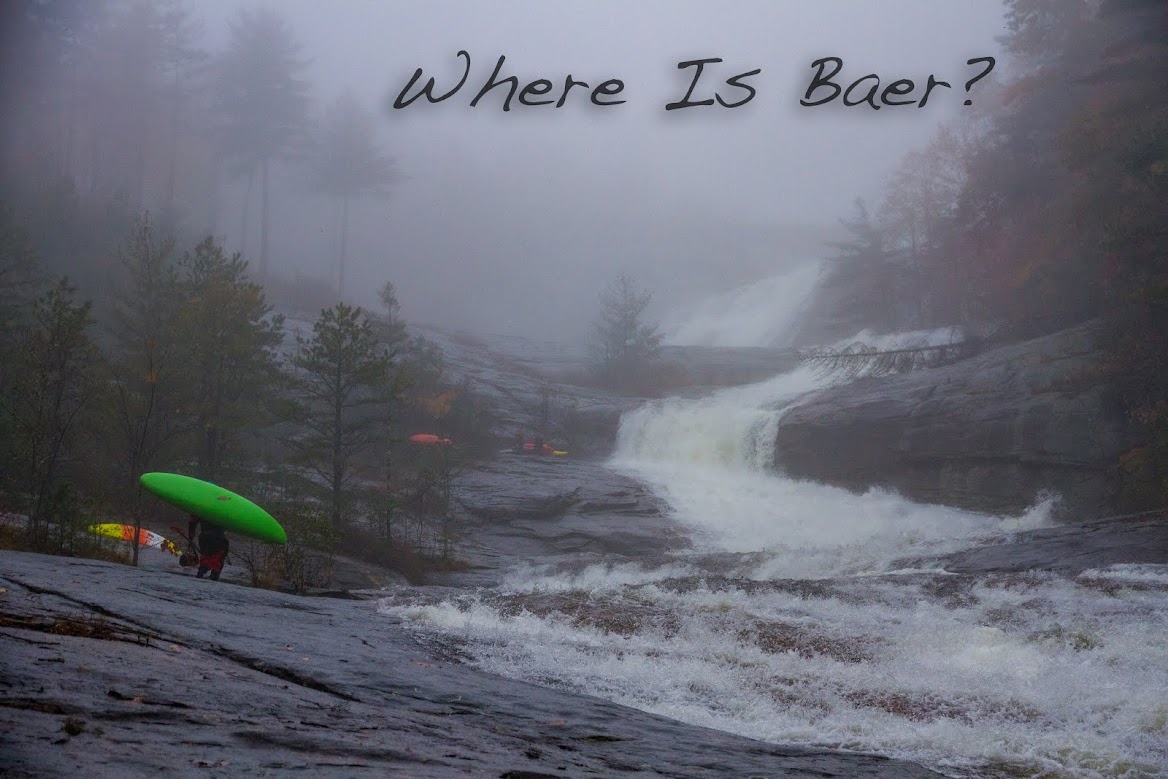Alerces Gorge
Rio Manso from
Chris Baer on
Vimeo.
 |
| Aeon Russo, Alerces Falls |
The
Upper Manso, or Argentine Manso is super fun; here are a few pictures, but that is not what this story is about.
 |
| Salto de Alerces |
 |
| Mark Taylor, coming out of the jungle |
 |
| Aeon Russo, Manso Gorge |
 |
| scouting another phallic named waterfall |
 |
| Aeon Russo, flat water paddle out |
During our time on the
Rio Puelo, we bumped into an old friend of mine: Tomas Binimelis. He spoke of yet another threatened and very unique river section, the Rio Manso. But he wasn’t speaking of the more commonly paddled Alerces Gorge section in Argentina, but a very remote and mysterious section on the Chilean side of the border. Bennie’s beta on what we would encounter in the isolated valley was limited, and my understanding of that valley was beyond inadequate.
Beta
Years ago I remembered both
Nate Mac and
Matias Nunez rambling about the obscure Rio Manso Chilean Gorge. Accounts of “epic” was all I could remember. I tried to reach out to them and other friends in the area, and unfortunately (fortunately), the Puelo Valley currently has next to no communication with the outside world.
 |
| "coloring book map" |
Our threesome (Aeon Russo, Mark Taylor, and Chris Baer) added a few new faces for the endeavor. Our newly amended crew now included Hamish Tills and Tomas Binimelis. We all started compiling our marginal beta, most of which was based upon hearsay and rumor, along with a few numbers from what Aeon so delicately referred to as the “coloring book map”. The alleged put-in, from the info that we could obtain, was four-hundred and twenty meters above sea level, and we were going to descend all the way down to just above sea level. The estimated distance was approximately thirty kilometers. After a quick mental conversion to the Imperial system, the river would fall at an average gradient of sixty-seven feet per mile for eighteen miles… a long one day event?
 |
| a bunch of boaters waiting on a boat |
Logistics
 |
| Tomas, chatting with the captain |
“Arduous” would be a massive understatement for this trip. Thankfully, Tomas, our fearless Chilean was hard at work orchestrating our impending journey. To get to the Manso put-in, we would drive up the Puelo valley to the Upper Puelo put-in. We would then hike thirty minutes upstream to a large eddy, await our next vessel, load ourselves and our gear onto a motor boat, and then go upriver into the headwaters of the Rio Puelo. We then exited the first boat at an unidentifiable beach, and hiked half a mile up the hillside to get our passports stamped out of Chile by the grumpy, under-caffeinated border guards at the ridiculously remote “Paso Puelo” (only accessible via boat). We hopped onto a slightly larger jet boat and skipped our way further up-stream. Launching up a solid class 3 rapid, the captain calmly mentioned that we had just attain-boofed our way into Argentina. Our passports were stamped into Argentina at the beautiful Parque Nacional Lago Puelo. Then we journeyed north via a family friend of Tomas in a pickup truck for four hours to Paso Leon. The road dead ends in Paso Leon. We then checked out of Argentina, crossed the Rio Manso by kayak, and then checked back into Chile on the other side. This single day of logistics would have taken me a week or more to contrive, but spectacularly, Tomas pulled it off like it was just another day in the office.
 |
| Paso Puelo |
|
|
 |
| end of the road |
 |
| heading to the border crossing for the fourth time in a single day |
On Water
 |
| Mark Taylor, picking his way through the siphon pile |
The tributary just North of the Rio Manso is the
Rio Cochamo. Shortly after setting off into our trip, the Rio Manso revealed its similarity to the Rio Cochamo: essentially gigantic boulders stacked on top of each other in a narrow canyon. There were literally siphons stacked upon siphons. Downstream progress slowed to a crawl.
 |
| Mark Taylor, Manso Chile |
The next ten hours were a blur of massive boulder gardens, countless sieves, live bait scouting, and way too many close calls. Late in the day after running a massive sieve-laden boulder garden, I caught a micro eddy in the middle of the river. Looking downstream, Tomas and Hamish were sitting thirty feet below. The water between us was exploding in every direction. Their paddles were straight up in the air (signaling that the rapid was ok). Mark, Aeon, and I dropped into the melee heedlessly; we were exhausted.
 |
| Aeon Russo, Rio Manso |
Every skill in my kayaking repertoire was being abused. Mentally, I was battered and my confidence started to fade.
The gorge glowed an amazing saffron hue as the sun set over the unrelenting canyon rim. We stopped on a rocky beach. Fourteen years of paddling class 5 rivers, and this was my first unexpected overnight. We collected every piece of driftwood on the “beach” and started a fire. No one was anticipating a night out. Food was slim and protection from the elements was absent. The rain started at about 2:00 AM, and sleep became unattainable.
The following morning the crew was moving exceptionally slowly. Most hadn’t gotten any real sleep. Thankfully the river had given up most of its gradient. Wearily, we paddled through sporadic class 3 for the final six kilometers to our take out.































